There are a lot of benefits to writing for Hackaday, but hands down one of the best is getting paid to fall down fascinating rabbit holes. These often — but not always — delightful journeys generally start with chance comments by readers, conversations with fellow writers, or just the random largesse of The Algorithm. Once steered in the right direction, a few mouse clicks are all it takes for the properly prepared mind to lose a few hours chasing down an interesting tale.
I’d like to say that’s exactly how this article came to be, but to be honest, I have no idea where I first heard about the prison camp lathe. I only know that I had a link to a PDF of an article written in 1949, and that was enough to get me going. It was probably a thread I shouldn’t have tugged on, but I’m glad I did because it unraveled into a story not only of mechanical engineering chops winning the day under difficult circumstances, but also of how ingenuity and determination can come together to make the unbearable a little less trying, and how social engineering is an important a skill if you want to survive the unsurvivable.
Finding Reggie
For as interesting a story as this is, source material is hard to come by. Searches for “prison camp lathe” all seem to point back to a single document written by one “R. Bradley, A.M.I.C.E” in 1949, describing the building of the lathe. The story, which has been published multiple times in various forms over the ensuing eight decades, is a fascinating read that’s naturally heavy on engineering details, given the subject matter and target audience. But one suspects there’s a lot more to the story, especially from the few tantalizing details of the exploits surrounding the tool’s creation that R. Bradley floats.
Tracking down more information about Bradley’s wartime experiences proved difficult, but not impossible. Thankfully, the United Kingdom’s National Archives Department has an immense trove of information from World War II, including a catalog of the index cards used by the Japanese Empire to keep track of captured Allied personnel. The cards are little more than “name, rank, and serial number” affairs, but that was enough to track down a prisoner named Reginald Bradley:
Now, it’s true that Reginald Bradley is an extremely British name, and probably common enough that this wasn’t the only Reggie Bradley serving in the Far East theater in World War II. And while the date of capture, 15 February 1942, agrees with the date listed in the lathe article, it also happens to be the date of the Fall of Singapore, the end of a seven-day battle between Allied (mainly British) forces and the Japanese Imperial Army and Navy that resulted in the loss of the island city-state. About 80,000 Allied troops were captured that day, increasing the odds of confusing this Reginald Bradley with the R. Bradley who wrote the article.
The clincher, though, is Reginald Bradley’s listed occupation on the prisoner card: “Chartered Civil Engineer.” Even better is the information captured in the remarks field, which shows that this prisoner is an Associate Member of the Institution of Civil Engineers, which agrees with the “A.C.I.M.E” abbreviation in the article’s byline. Add to that the fact that the rank of Captain in the Royal Artillery listed on the card agrees with the author’s description of himself, and it seems we have our man. (Note: it’s easy to fall into the genealogical rabbit hole at this point, especially with an address and mother’s name to work with. Trust me, though; that way lies madness. It’s enough that the index card pictured above cost me £25 to retrieve from one of the National Archive’s “trusted partner” sites.)
The Royal Society of Social Engineers
The first big question about Captain Bradley is how he managed to survive his term as a prisoner of the Japanese Empire, which, as a non-signatory to the various international conventions and agreements on the treatment of prisoners of war, was famed for its poor treatment of POWs. Especially egregious was the treatment of prisoners assigned to build the Burma Death Railway, an infrastructure project that claimed 45 lives for every mile of track built. Given that his intake card clearly states his civil engineering credentials with a specialty in highways and bridges, one would think he was an obvious choice to be sent out into the jungle.
Rather than suffering that fate, Captain Bradley was sent to the infamous prison camp that had been established in Singapore’s Changi Prison complex. While not pleasant, it was infinitely preferable to the trials of the jungle, but how Bradley avoided that fate is unclear, as he doesn’t mention the topic at all in his article. He does, however, relate a couple of anecdotes that suggest that bridges and highways weren’t his only engineering specialty. Captain Bradley clearly had some social engineering chops too, which seem to have served him in good stead during his internment.
Within the first year of his term, he and his fellow officers had stolen so many tools from their Japanese captors that it was beginning to be a problem to safely stash their booty. They solved the problem by chatting up a Japanese guard under the ruse of wanting to learn a little Japanese. After having the guard demonstrate some simple pictograms like “dog” and “tree,” they made the leap to requesting the symbol for “workshop.” Miraculously, the guard fell for it and showed them the proper strokes, which they copied to a board and hung outside the officer’s hut between guard changes. The new guard assumed the switch from hut to shop was legitimate, and the prisoners could finally lay out all their tools openly and acquire more.
Another bit of social engineering that Captain Bradley managed, and probably what spared him from railway work, was his reputation as a learned man with a wide variety of interests. This captured the attention of a Japanese general, who engaged the captain in long discussions on astronomy. Captain Bradley appears to have cultivated this relationship carefully, enough so that he felt free to gripe to the general about the poor state of the now officially sanctioned workshop, which had been moved to the camp’s hospital block. A care package of fresh tools and supplies, including drill bits, hacksaw blades, and a supply of aluminum rivets, which would prove invaluable, soon arrived. These joined their pilfered tool collection along with a small set of machines that were in the original hospital shop, which included a hand-operated bench drill, a forge, some vises, and crucially, a small lathe. This would prove vital in the efforts to come, but meanwhile, the shop’s twelve prisoner-machinists were put to work making things for the hospital, mainly surgical instruments and, sadly, prosthetic limbs.
The Purdon Joint
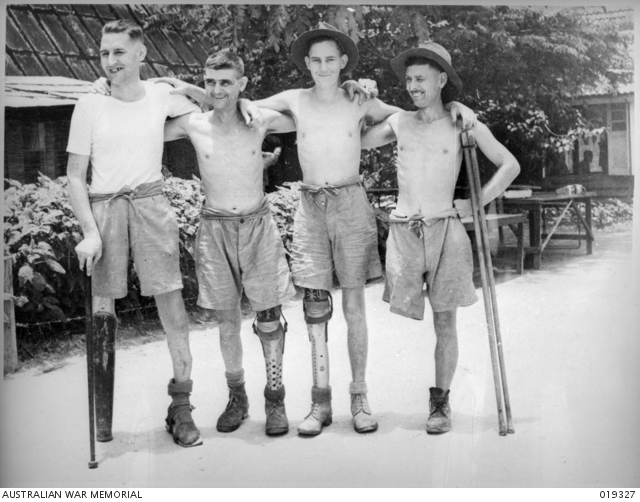
In his article, Captain Bradley devotes curiously little space to descriptions of these prosthetics, especially since he suggests that his “link-motion” design was innovative enough that prisoners who had lost legs to infection, a common outcome even for small wounds given the poor nutrition and even poorer sanitation in the camps, were able to walk well enough that a surgeon in the camp, a British colonel, noted that “It is impossible to tell that the walker is minus a natural leg.” The lack of detail on the knee’s design might also be due to modesty, since other descriptions of these prostheses credit the design of the knee joint to Warrant Officer Arthur Henry Mason Purdon, who was interned at Changi during this period.
A number of examples of the prosthetic legs manufactured at “The Artificial Limb Factory,” as the shop was now dubbed, still exist in museum collections today. The consensus design seems to accommodate below-the-knee amputees with a leather and canvas strap for the thigh, a hinge to transfer most of the load from the lower leg to the thigh around the potentially compromised knee, a calf with a stump socket sculpted from aluminum, and a multi-piece foot carved from wood. The aluminum was often salvaged from downed aircraft, hammered into shape and riveted together. When the gifted supply of aluminum rivets was depleted, Bradley says that new ones were made on the lathe using copper harvested from heavy electrical cables in the camp.
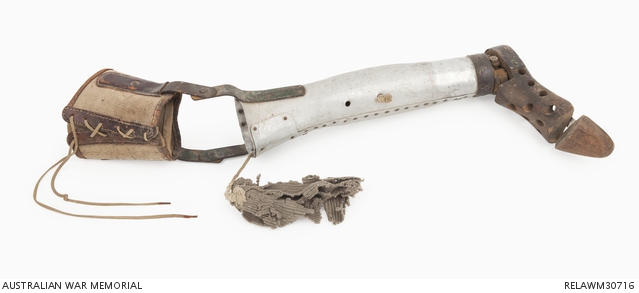
It Takes a Lathe to Make a Lathe
While the Limb Factory was by now a going concern that produced items necessary to prisoners and captors alike, life in a prison camp is rarely fair, and the threat of the entire shop being dismantled at any moment weighed heavily on Captain Bradley and his colleagues. That’s what spurred the creation of the lathe detailed in Bradley’s paper — a lathe that the Japanese wouldn’t know about, and that was small enough to hide quickly, or even stuff into a pack and take on a forced march.
The paper goes into great detail on the construction of the lathe, which started with the procurement of a scrap of 3″ by 3″ steel bar. Cold chisels and drills were used to shape the metal before surfacing it on one of the other lathes using a fly cutter. Slides were similarly chipped from 1/2″ thick plate, and when a suitable piece of stock for the headstock couldn’t be found, one was cast from scrap aluminum using a sand mold in a flask made from sheet steel harvested from a barracks locker.
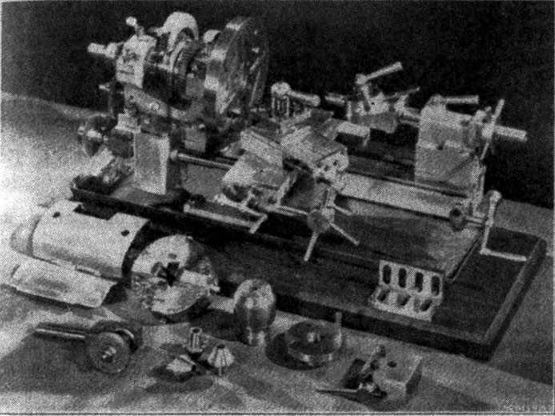
Between his other shop duties and the rigors of prison life, Captain Bradley continued his surreptitious work on the lathe, and despite interruptions from camp relocations, was able to complete it in about 600 hours spread over six months. He developed ingenious ways to power the lathe using old dynamos and truck batteries. The lathe was used for general maintenance work in the shop, such as making taps and dies to replace worn and broken ones from the original gift of tools bequeathed by the Japanese general.
With the end of the war approaching, the lathe was put to use making the mechanical parts needed for prison camp radios, some of which were ingeniously hidden in wooden beams of the barracks or even within the leg of a small table. The prisoners used these sets to listen for escape and evasion orders from Allied command, or to just get any news of when their imprisonment might be over.
That day would come soon after the atomic bombing of Hiroshima and Nagasaki and Japan’s subsequent surrender in August 1945. The Changi prison camp was liberated about two weeks later, with the survivors returning first to military and later to civilian life. Warrant Officer Purdon, who was already in his 40s when he enlisted, was awarded a Distinguished Combat Medal for his courage during the Battle of Singapore. As for Captain Bradley, his trail goes cold after the war, and there don’t seem to be any publicly available pictures of him. He was decorated by King George VI after the war, though, “for gallant and distinguished service while a prisoner of war,” as were most other POWs. The award was well-earned, of course, but an understatement in the extreme for someone who did so much to lighten the load of his comrades in arms.
Featured image: “Warrant Officer Arthur Henry Mason Purdon, Changi Prison Camp, Singapore. c. 1945“, Australian War Memorial.

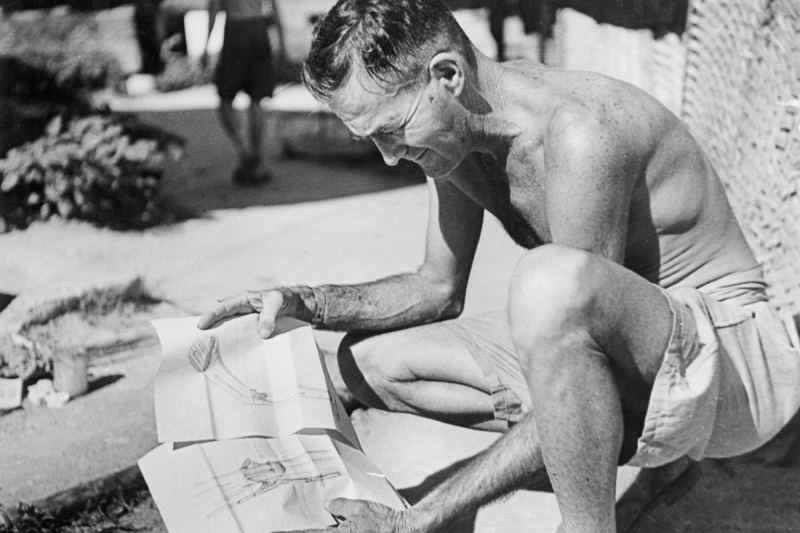
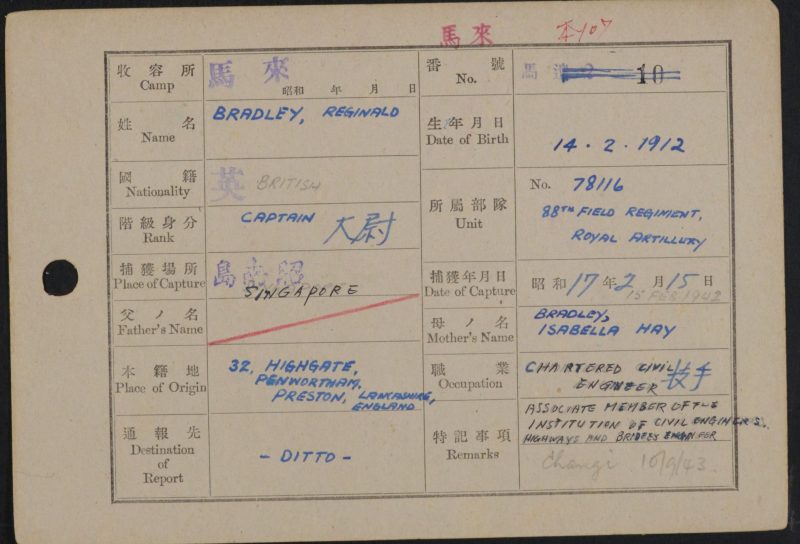













Somewhere in this story is a movie I’d watch.
King Rat (1965)
https://archive.org/details/king-rat-1965.ia
Absolutely fascinating….
I have a number of POW escape books, nonfiction. The ingenuity these guys displayed is nothing short of amazing. The Colditz cock (glider) down to the photography that the Confederate soldiers did in a POW camp on Lake Erie (made and developed tintypes and I think they built the camera, too).
Same here, I’m not much for the muck & bullets war stories but the other stuff – espionage, deception, resistance, and survival in places like PoW camps are an almost endless source of incredible tales of human ingenuity.
Some of the resistance & espionage actions even count as early hacking – social engineering your way into somewhere you shouldn’t be and gaining access to information you shouldn’t see before managing to capture it and communicate it back.
Do you have any book recommendations?
Isn’t this the Acme (you saw what I did there, right?) of the inventors’/hackers’/scientists’ challenge trope? Lock bright people up in a stressful (dangerous) situation, provide very limited resources and see what they come up with. Everything from A Connecticut Yankee in King Arthur’s Court to Junkyard Wars (before they left the UK) is based on a similar idea.
Except this isn’t fiction or a show that people can leave at work after sundown. Also the social engineering may have gone both ways – somewhere in the back of my mind, I wonder if the camp commandant wasn’t glad to have this going on rather than fomenting escape plans, making weapons, or worse.
FYI “Junkyard Wars” (or “Scrapheap Challenge”, as we knew it in the UK) is coming back with an EV twist, under the name “Zapheap”
See https://fullycharged.show/zapheap/
That is fascinating, and I’m really impressed they managed to create a lathe so fully featured without the Japanese knowing. That picture is sadly not super sharp, but it certainly looks likes a nice little machine considering. With a nice little pile of useful accessories, which I have to wonder if they are pilfered or custom built for the machine.
Also curious what gears it would be capable of cutting (even if its cutting them very slowly with a shaper type action of the cross slide) – it looks like it has a toothed gear on the spindle with some sort of stop that could lock it in place which would give you any number of gear teeth you can build from the prime divisors of that gear, but that is likely somewhat too limited on its own to make gears to then produce tap and dies that match any standard thread you’d want to match with (though of course it might just produce its own rather arbitrary thread pitch – if you are making every part it doesn’t matter if much). Though it looks somewhat plausible a worm gear might be meant to engage with that position locking/drive gear, the teeth seem to have a slant that would support that, in which case if the fit between worm and wheel is good all you need is a precise enough handle to turn to dial in exactly whatever rotation you want.
One thing I can say for sure is I’d definitely not want to be the guy lugging that around, it is going to be rather heavy. Also find it hard to believe it would really have practical purpose beyond the mental health of the folks making it. Which is of course good enough reason to do so barring a more useful idea.
I think the lathe story is in Guy Lautard’s “Machinist’s Bedside Reader”. It provides a lot of detail.
It isn’t exactly appropriate, but look up Douglas Bader. His story is nothing short of amazing.
A number of years ago I worked with somebody who’d spent time (I don’t know in what capacity) with the Air Scouts at Croydon: I can’t remember whether he explicitly said that it was the original Aerodrome (which would narrow the possible dates of the story) or if they were based elsewhere by then.
They were visited by Bader, who after watching the gliders for a while said “Can I have a go?”.
“I’m sorry but…”
“WHAT!!!!!”
“…you’ll need to be checked out first.”
So they checked him out on whatever they were flying and (winch?) launched him, then somebody patched the RT to the Tannoy: and all they could hear was
“Blaaady marvelous! Blaaaady marvelous!!!”
It’s worth noting that according to Wp Bader continued flying powered aircraft until 1979, so it would be wrong to interpret this as the first time he’d flown anything since the war.
Also worth looking up the story of Alex Ross, who was effectively Bader’s servant in Colditz, as it gives a more fully rounded picture of Bader.
A hero yes, but also a bloody awful person.